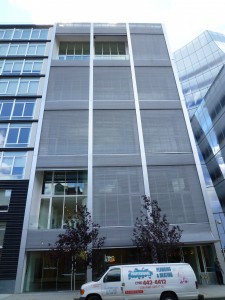Corridors
Jon Gertner writes an interesting article in the February 25 New York Times on technological innovation. It is illustrated by a 1966 photograph of researchers standing outside their offices in the Bell Lab building in Murray Hill, N.J. An endless, featureless, rather wide corridor with a strip of fluorescent lighting straight down the center of an acoustic tile ceiling. A model of dreary, unimaginative, bureaucratic design, right? Wrong. As Gertner writes, the building was conceived by Mervin Kelly (who later became Bell Labs’ chairman of the board) in 1941, and the long corridor,

